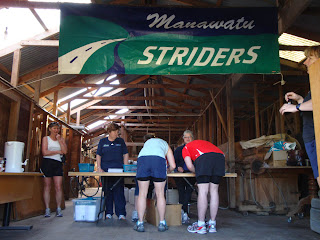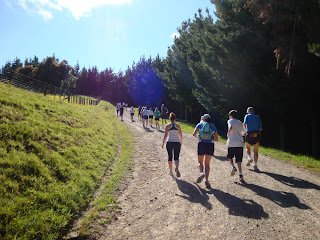 |
| Gerry struggling from turkey and wine overload. |
Visiting friends in New Plymouth for X-mas (thanks Deon and Henriette!), Gerry and I decided to enter for the Olex Bell Block 10km run. A good way to rid some of the turkey and trifle reserve kilos. And in any case, we’re on a mission to get to marathon fitness level again.
 |
| Sharing the path with some other runners also working off the X-mas binge. |
After some negotiating and marathon-hunting on the internet, Gerry found some lovely runs and decided impromptu to enter for two of them. As we know, nothing like a good challenge to get you out the door for the sometimes "challenging" training sessions. These races – the Dual (on 26 March) and the T42 (held on 7 May) – both seem like exciting scenic runs in the country and are both classified as trail runs. And if we can keep up the training and not get injured, we might sneak in the Mountain to Surf marathon at the beginning of March. Having done this race in 2008, I have a soft spot for the event, which was well presented by very friendly and helpful organizers. They even offered us foreigners a cottage to overnight before the race.
 |
| The iconic Big Wave Cafe is a landmark on the Coastal Walkway. |
So, off we went to the Coastal Walkway in New Plymouth, a path that runs next to the sea for 10km from Port Taranaki to Hickford Park in Bell Block. We decided to park at the Fitzroy Beach Resort and run to Len Lye’s Wind Wand (or as Billy Connolly puts it “a testicle on a stick”) – a central section with a distance of just over 2.5km one way.
It was a lovely overcast morning with little wind, and as it turned out we weren’t the only guilt-ridden runners out there. Plenty of other runners, walkers and cyclists enjoy the pleasure of having a scenic path where you can get some fresh air and a wee bit of exercise. We finished the approximately 5.5km in 35 minutes.
 |
| Gerry rounding a corner on the last stretch of our rave run. |
The rest of the day went by quickly and fairly uneventful – with some careful eating and snacking: you don’t want to go on empty and you also know from past experiences you’d rather want to forget, that running on a pancake-carbo-load doesn’t work either.
The Olex Bell Block 10km race
 |
| Gerry said the numbering system made him feel like a triathlete, except that the number is on the wrong body part! :) |
 |
| A large Boxing Day field lining up at the start. |
Shortly after five in the afternoon we made our way to Bell Block to pick up our race numbers at the registration desk. After a bit of confusion, it turned our that our names weren’t added to the list, but fortunately the friendly organizer knew about us, saying “oh, you’re the guys from Palmerston North”, which added a bit of a personal touch.
With my entry number on my hand, we lined up together with 400-odd other runners and walkers. I’m amazed at the amount of participants who turned up on Boxing Day with dogs, baby joggers, twin baby joggers, kids, prams, grandma’s and grandpa’s. A very relaxing and festive evening with perfect weather.
 |
| One down, nine to go! |
 |
| Single track section on the Mangati Walkway. |
After the rules were read (shouted!) out to us (the PA system died on the organizers), the lady standing on the hood of a Toyota RAV shouted something along the lines of “okey, GO!” and we were off.
 |
| Being right next to the sea is no guarantee for a flat run. |
The first half a kilometer which is mostly downhill, is run in the suburb, after which you turn off onto the Mangati Walkway, a single track path running partially next to a little stream. This is where you hit the first proper hill. It levels out a bit, then a downhill, more uphill and you soon realize that the race is not as flat and fast as you thought it would be. I was keeping an eye out for a race-walker in front of us and was thinking to myself that if only I could stay with him, we should be okey. He was going at a steady fairly fast pace, measured by the sound of my panting. After the morning’s 5.5km run, I was hoping to cover the 10km in less than 70 minutes – a comfortable pace, but not going all out.
 |
| Runners making their way up Parklands Avenue. |
You reach the first kilometer marker still on the walkway and after about a kay of off-road running, you turn back onto the tar road by the beachfront. Here we reached a significant little hill, which reminded me of the very first running of the Waterfall Mall marathon (2003) near Rustenburg in South Africa: as we reached the first hill, Bruce Fordyce (joined by the actor David Vlok, one of the Gladiator ladies [possibly Fire?] and everybody else who could hang on to their 5 min/km pace at the time), said: “heads down, swing your arms and ‘bytvas’!”. Whenever I reach a hill, I will always remember his words. I guess having the privilege of running a race or part thereof with a legend will always bring back special memories.
 |
| Gerry making a turn at a short in and out section just after the 4/9km mark. |
Between the second and third kilometer marker you have Mt Taranaki as the backdrop, but some clouds obscure its magnificence. The undulating route continues through the suburb and after five kilometers, we turn to do the second lap of the same course.
 |
| Round number two! |
 |
| A paved section between houses that takes you onto the walkway. |
 |
| Gerry crossing a little bridge on the walkway. |
Most of the participants seem to have done the 2.5km and 5km runs, because after the turn I only saw other runners in a distance with no one behind. The second lap seemed almost a bit easier, maybe because you knew what to expect, and we finished in an impressive time of 59:50, breaking the one hour barrier – much faster than I anticipated, especially after the morning run. Seems like a diet of turkey, trifle and wine isn’t so bad after all!
 |
| Whoa - check that time! not too shabby for only two months worth of training (and the occasional quick stop for pics) :). |



















